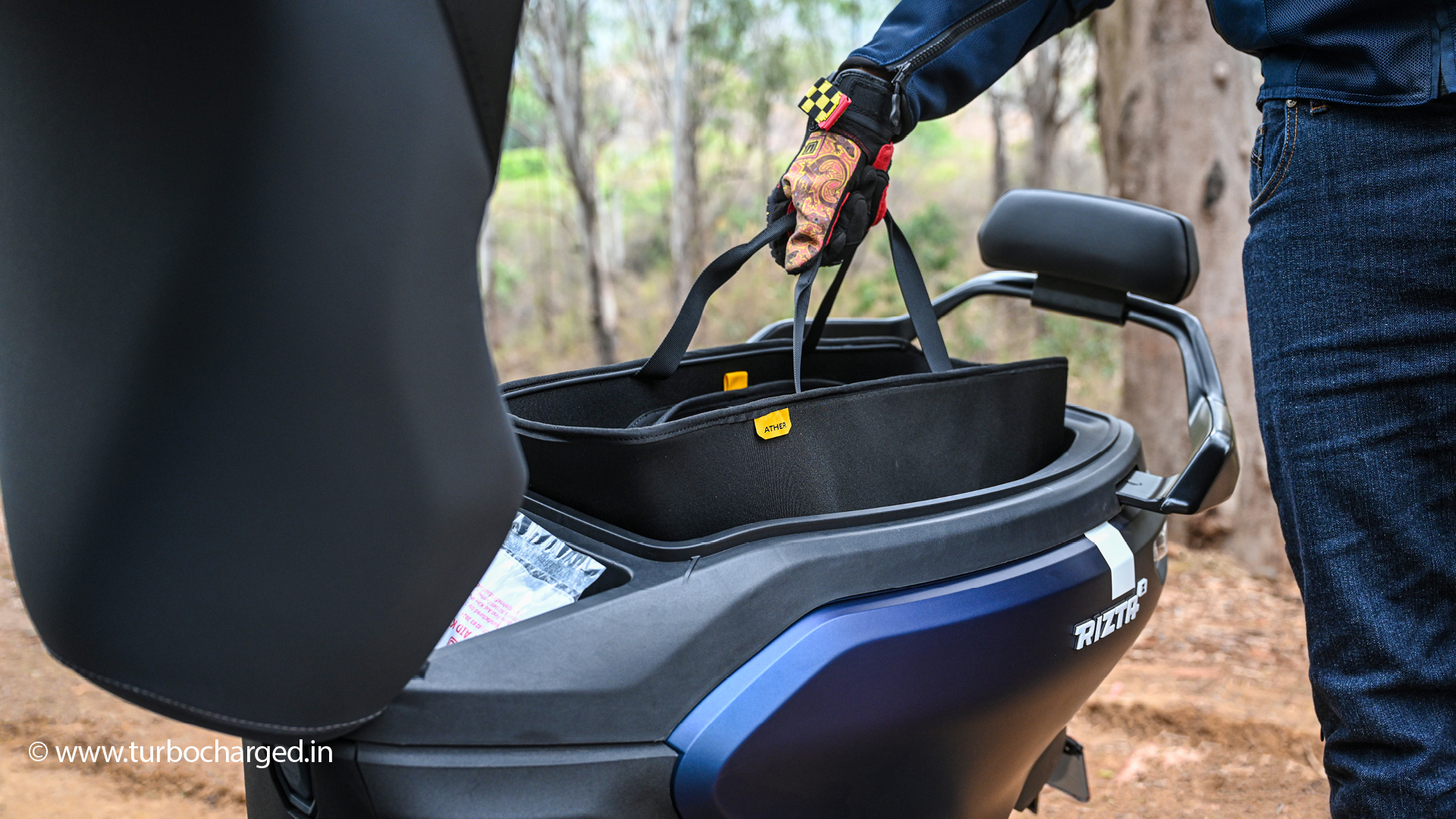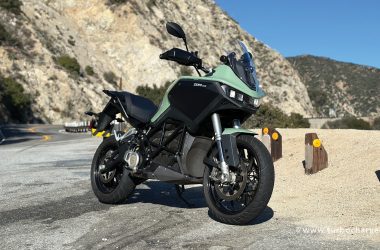The term “Rizz” is fairly new and used by Gen-Z to refer to a person’s ability to attract attention and generate romantic interest. Of course, this is not what Ather aims to achieve with the Rizta, its first family scooter. Ather has focused on building a scooter that scores high on practicality and serves all members of a typical Indian family. How well does it manage to do that? We rode the scooter in and around Nandi Hills, Bengaluru, to find out.

Unlike the 450X’s angular and sporty design, the Rizta goes for the conventional scooter look. The front apron features a boxy design with the LED headlamps and turn indicators placed in a single unit in the centre. The rear is a typical Ather affair with a sleek LED tail lamp and integrated turn indicators. The side profile may not be to everyone’s taste as it looks quite bulky, making the 12-inch rear wheel look puny. The reason for this is that the Rizta uses a completely new rear frame that is longer, wider, and sits lower than that of the 450X. This has allowed Ather to fit it with the largest seat in its segment. It can easily accommodate two plus-sized adults with still enough space to carry items between them. Additionally, you get a massive 34 litres of underseat storage, which can easily fit a full-sized helmet and much more! There’s even a small pocket that solves the common issue of separately storing the cloth you use to clean your scooter. Of course, you can also use it to store small items like a wallet. Quite thoughtful!

The practicality extends to the accessory options, the best of which, in my opinion, is a storage organiser for the boot. It’s like a bag you use to carry groceries, which nicely integrates with the boot. Plus, if the boot isn’t enough, you can opt for a 22-litre frunk, which is made of elastic material with four pockets and is integrated near the floorboard area. So, full marks to the Rizta in terms of practicality. We also faced no issues with build quality, and it has an overall premium feel.

In terms of features, the majority are integrated into the 7-inch TFT instrument cluster. It doesn’t have touchscreen functionality; instead, it can be operated with a four-way toggle switch on its left side. The Rizta is currently running on Atherstack 6.0, which comes with a new User Interface (UI) and features like WhatsApp notifications and the option to deny a call with a message. The screen itself isn’t the brightest, and the operating system felt quite laggy on our test units. Ather says they are working to fix these issues before deliveries begin for the Rizta.

In the safety department, the Rizta gets a new Skid Control feature, which is a traction control system that prevents rear tyre slippage on low-grip surfaces. Additionally, it has Emergency Brake Lights—the tail lamp blinks under emergency braking conditions to alert the vehicle behind—and Fall Safe, which turns off the motor in case of an accident to prevent accidental acceleration while picking the scooter back up.
The Rizta gets a 4.3kW motor that puts out 22Nm of torque. It comes with two battery pack options: a 2.9kWh and a 3.7kWh unit, with an IDC-claimed range of 123km and 159km, respectively. We tested the former. There are two modes on offer: SmartEco and Zip. As the name suggests, SmartEco is to get the most range out of the battery pack. The performance in SmartEco should suffice for most use cases, as you can hit a respectable top speed of 65kmph, and the acceleration feels brisk. However, the scooter did struggle to climb a steep incline post-35kmph with my weight (70 kg).

Zip mode gives you access to full power, and the scooter easily hits its claimed top speed of 80km/h. It still isn’t as zippy (pun intended) as the 450X, but that is exactly what Ather was aiming for. The overall performance can be compared to a 110cc ICE scooter, but the Rizta feels a lot quicker and more relaxed at sustaining top speeds.
The base ‘S’ and ‘Z’ variants with the 2.9kWh battery pack come with a 350W portable charger, while the top-spec variant gets a 700W portable charger. The 0-80 percent charging time varies between 5 hours 45 minutes and 4 hours 30 minutes, depending on your variant. The good thing is that all variants are compatible with the Ather Grid for faster charging times.

One of the other strong points of the Ather Rizta is its underpinnings. Despite the longer rear frame, the weight management on the scooter is excellent. The centre of gravity is low, thanks to the battery being placed under the floorboard, and you don’t feel the 119kg kerb weight of the scooter while manoeuvring it at low speeds. The suspension setup includes telescopic forks up front and a monoshock at the rear, and the ride feels plush for the most part. That being said, it still has an underlying firmness, but that works in its favour in the handling department. It doesn’t change directions as quickly as the 450X, but it still feels fun to ride for a family scooter.

Braking duties are handled by a front disc and rear drum brake, with a combi-braking system. The brakes do a good job of shedding speeds, but we did notice the rear locking up quicker than expected. However, there is another option for braking: Magic Twist. This tech first debuted on the Apex 450, and the Rizta gets it too! All you need to do is twist the throttle in the opposite direction to activate regenerative braking, and it can bring the scooter to a complete stop. It is most effective at 50km/h and below, and it works at 100 percent battery as well!

To summarise, Ather’s first attempt at making a family scooter looks successful. The pricing, too—Rs 1.10 – 1.45 lakh (ex-showroom)—is right on par with its competitors like the TVS iQube, Bajaj Chetak, and River Indie. The Rizta comes across as a well-rounded family scooter with immense practicality, premium build, decent performance, and overall a well-engineered product. Plus, it benefits from Ather’s vast network of touchpoints (2,899+), offering customers extra peace of mind. To conclude, the Rizta has certainly got the ‘Rizz’!










